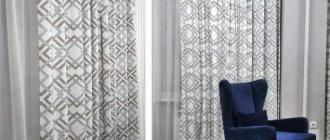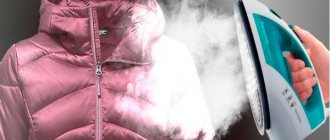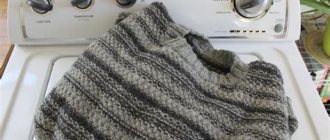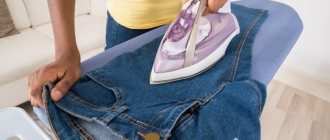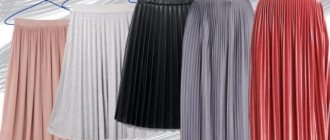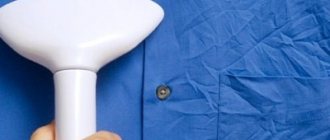Curtains are practically the main element of the interior, as they occupy a fairly large area of any room. Therefore, they should always look amazing. It is not so important whether the curtains are expensive or not, the main thing is that they are clean and ironed. And if, in principle, there are no issues with washing, then there are a lot of disputes about ironing. Some people prefer a steam generator, some prefer an iron, while others hang the curtains while still damp. And besides, it’s not so easy to perfectly iron large curtains. In the article below we will learn how to iron curtains without removing them, the basic rules for caring for curtains and the subtleties of ironing depending on the fabric. Happy learning!
Is it possible to iron curtains with an iron?
Most of the materials from which curtains are made are iron-resistant. To prevent the smoothing process from becoming a torment, you need to arrange your work area using one trick:
- Place the ironing board next to the window.
- Iron the top.
- Hook it on the ledge.
- Continue ironing the bottom.
The method speeds up ironing and is applicable to various curtains, but is most suitable for those that wrinkle easily. Firstly, the fabric on the ironing board does not need to be constantly maintained, secondly, this way you can prevent the occurrence of unwanted folds.
Care instructions
Curtains, like any object, trap dust, tobacco smoke particles, animal hair, pollen and other contaminants.
If cleanliness in your home is important to you, then the curtains simply need to be cleaned from time to time.
- Airing curtains. This recommendation is the simplest and most effective way to keep curtains fresh. Open the window wide, draw the curtains and let them flutter in the wind for a few hours. The smell of dust that appears in the curtains over time will disappear. If you can carry out this procedure at least once every few weeks, your curtains will remain fresh and clean for a long time.
- Cleaning curtains with a vacuum cleaner. Curtains can be cleaned with a vacuum cleaner. Regular removal of dust is necessary to ensure that its particles do not eat into the fibers of the fabric, because once dust penetrates the structure of the fabric, it is not easy to remove. You need to clean curtains with a vacuum cleaner with a special soft brush attachment, paying special attention to their insides, folds and fringes.
- Steam treatment. To refresh your curtains, you can use a steam generator. But you should know that when cleaning with steam, only dust is removed from the surface of the curtains. Also, fabrics made from natural fibers and their mixtures should not be steam-treated.
- From time to time, take care of the curtain rod: spray a cleaner with an antistatic agent on the curtain rod itself and the top of the curtains - this will help prevent dust from accumulating, and in addition, the curtains themselves will move more easily. The curtain rod itself should be cleaned regularly using detergent and a soft brush. Pay special attention to the fasteners: rings and other small parts “love” to collect dust!
- Do not dry curtains in the sun. Direct exposure to sunlight on fabric can result in unsightly yellowing and loss of the primary color.
- When ordering curtains, immediately check with the seller or designer how to properly care for this type of fabric. Self-will when caring for curtains will result in loss of shape, color, burning of the fabric and other problems that you hardly need.
By following these simple rules and recommendations, you will keep your curtains in their original appearance. Treat your item with love and it will last you for years!
What iron setting should you use to iron?
A weakly heated device will not create problems: you will simply be left with a crumpled curtain. Another thing is an iron heated to extremely high temperatures. One touch, and you will ruin the curtain, and then your own mood.
It is important not to confuse the ironing mode by correctly deciphering the meaning of the symbol on the curtain or fabric label:
| Number of points on the iron thermostat: | Permissible temperature: |
| 3 | up to 200°C |
| 2 | no higher than 150°C |
| 1 | allow heating up to 110°C |
The crossed out iron icon means that ironing, including steam, is prohibited.
Maximum numbers are not scary, as a rule, for natural materials, including cotton and linen. The work will go faster if you iron a curtain that is not completely dry, or a curtain that is dry but through damp gauze. A good old way is to spray with water from a spray bottle.
The most capricious are polyester and viscose, which melt under a hot iron. They are ironed from the inside out, first placing the iron on the edge of the curtain to check the degree of heating.
Basic mistakes when ironing
Due to inexperience, many housewives spoil curtains during the first ironing. Let's look at the most common mistakes.
- Wrong choice and ignorance of the temperature regime for a certain curtain material. Due to such an error, the fabric begins to shrink in folds, subsequently causing burns and holes. When the defect is somewhere on the edge, you can try to cut off a piece or sew it up somehow, but if there is a hole in the middle of the fabric, the curtain goes to the trash, since even the most experienced seamstress cannot hide such a defect.
- Untimely ironing of fabric. The fabric becomes dry and difficult to iron. You have to constantly moisten it, which can lead to the curtain losing its shape and color.
- Dirty iron or steam generator platform. As a result, the steam comes out dirty and leaves marks on the curtain fabric. It’s not so bad if the curtain is dark, but if the fabric is white, it’s a disaster. You have to remove the curtain again, send it to the wash, dry it, hang it and iron it again. Again, frequent contact of the fabric with water can deform it. To clean carbon deposits on the platform, use a special pencil, which is sold in almost any hardware store. Take care of this in advance so as not to redo the work, save your time and effort.
Smoothing without iron
You can give curtains a sleek look in a variety of ways, such as hanging them over a bathtub filled with hot water (with the door closed tightly). This steaming takes 20-30 minutes, then the fabric is straightened by hand, attached to the curtain rod and left until completely dry.
The second method resembles the first, but excludes the bath step:
- The wrung out, but moderately damp curtains are fixed to the cornice.
- Severely sagging fabric is lifted and attached to the crossbar.
- If the curtain wrinkles a little, it is wrapped a couple of times around the cornice.
- The drying curtain is gradually unrolled and lowered.
- The bruises are carefully straightened out, smoothing them with your hands.
- It takes up to 12 hours for massive curtains to dry.
The damp fabric straightens out under its own weight, which makes it possible to do without an iron.
Smoothing with a steamer
This is how hanging curtains recently purchased or washed usually get rid of wrinkles. The more powerful the steamer, the more steam it generates, speeding up the work.
Look at the volume of the tank: if the tank is small, you will have to fill it with water 2-3 times if the curtains are wide and long.
A vertical steamer rarely needs an extension cord, which cannot be said about small household models. When choosing a mode, proceed from the composition of the fabric. A good device emits steam within 30-45 seconds. after switching on.
Curtains are ironed slowly, directing steam from the iron, repeating the movement several times if wrinkles remain. The fabric is worked from top to bottom, slightly stretching.
How to straighten curtains without removing them from the curtain rod
If you haven’t had time to get a steamer, try a few other techniques approved by housewives.
Without iron
The method is applicable to synthetic, low-wrinkle materials. The washed curtains are hung over the bathroom, waiting for the water to drain, then they are returned to their usual place (window). Here they smooth it out with their hands, leaving it to dry, spreading old sheets or rags under them to absorb moisture.
Steam
Take a large container of boiling water and place it near the curtains hanging from the curtain rod. The steam will penetrate the fabric by weight, softening it and smoothing out unevenness.
You can enhance the steam effect by sprinkling water with a few drops of vinegar on the curtains or pressing wet gauze to problem areas. Finally, the curtains are straightened by hand.
Iron
In this case, it acts as a steamer. Proceed like this:
- Wear gloves to protect against burns.
- Fasten the damp curtains to the window so that they open slightly under their own weight.
- Straighten the creases by hand.
- Fill the iron (with steam function) with water and turn it on.
- Iron the curtains with steam, bringing the iron closer to 0.3-0.4 m.
Move the device from top to bottom. Steaming a thick curtain will take longer than steaming a thin curtain.
Lambrequin: the most complex element
Lambrequin is an elegant decorative drapery that is attached to the top of the curtain composition . For the most part, this decoration of a window opening is made from the same fabric as the curtain.
The shape of the lambrequin can be very different, most often with a large number of folds.
Some lambrequins cannot be washed; they are cleaned by steaming or sent to dry cleaning.
The complex shape of the drapery is almost impossible to straighten with an iron . Steaming comes to the rescue.
For lambrequins without fixed draperies, the same ironing is possible as for the curtains themselves. Lambrequins on a rigid base are treated only with steam or dry-cleaned.
How to iron thick fabric
In this category, velvet is considered one of the most finicky: it is forbidden to wring it out or iron it when wet. Washed large curtains are wrung out using terry sheets.
The curtains are laid between the sheets, gently pressing them with your hands. The less you wrinkle the velvet, the easier it will be to iron.
Do not touch velvet with an iron if the fabric is not completely dry, but iron it exclusively along the pile.
In order not to spoil the luxurious appearance of the velvet when ironing, terry towels are placed under the ironing board. It is better to iron other thick fabrics with steam, without exceeding the recommended temperature.
Tips and prohibitions
Some useful tips:
- When purchasing curtains, you should check for a label with information about proper care. If it is not available, it is better to consult with the seller what fabric they are made of and whether the product can be washed and ironed, and at what temperatures.
- If you have doubts about the name and properties of the fabric, it is recommended to contact a dry cleaner for the first wash.
Specialists will perform high-quality cleaning of curtains and give recommendations for further independent care. - Only freshly washed curtains need to be ironed. Otherwise, stains and streaks may appear on the fabric, especially when treated with steam.
Before ironing, you must clean the soleplate of the iron (using a special pencil or spray).
Even a small lint, invisible to the eye, can melt and stick to the fabric when heated.- Curtains made of silk, nylon, polyester, organza and chiffon are ironed without steam, so as not to cause deformation of the fabrics.
- Products with embroidery, beads or rhinestones are ironed from the reverse side. When in contact with a hot surface, decorative elements may melt and stick to the soleplate, damaging both the iron and the curtain.
- For the front side of the canvases, gauze or fabric linings are used.
Smoothing wrinkled tulle
The task is tedious both because of the size of the canvas and its constant sliding off the board. Tulle curtains can be smoothed out well with a steamer, especially if they are decorated with small decorative elements (that do not tolerate hot soles).
Many types of tulle tolerate traditional ironing well. Just don’t forget about the appropriate setting on the iron. Tulle, more than other thin materials, requires a test touch with the heated base of the iron to a piece of fabric. It doesn’t stick, which means you can continue ironing.
Steam generator or steam cleaner: what to choose?
In terms of their functions, a steam cleaner and a steam generator are completely different devices. The first, as the name suggests, is designed to clean things up. A steam generator is a device designed specifically for ironing. Therefore, if the task is to straighten the curtains, then it would be more correct to use a steam generator. If you need to clean some things in the house, then the cleaning function, which means a steam cleaner, will come in handy. It is impossible to say for sure which device you will need most in your household, so a situation often occurs when you have both a steam cleaner and a steam generator at home.
How to wash curtains without ironing
The tips are simple - wash in a delicate mode, with a water temperature of 30-40 °C, do not spin, and immediately hang it on a curtain rod. This way you can wash curtains made of linen, reaper, organza, polyester, and silk.
Thread curtains do not need to be ironed, but they must be washed correctly. To avoid tangling, they are tied with cords along their entire length and then placed in a bag. Medium spin possible. After washing, the thread curtains are hooked to the curtain rod, where they dry.
Ironing is contraindicated for shower curtains (made from various waterproof materials), although they require regular washing without drying or spinning. Vinyl, for example, after washing, is hung over the bathtub, allowing the water to drain. Instead of an iron, a household hair dryer is often used, straightening the folds with hot air.

